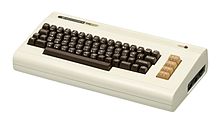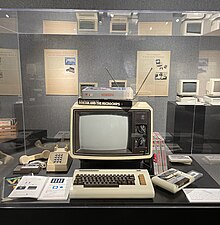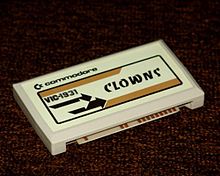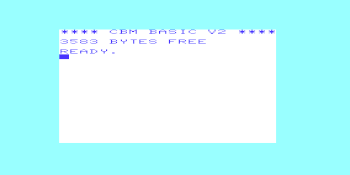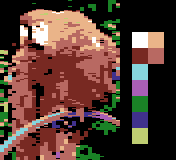
The Commodore 64, also known as the C64, is an 8-bit home computer introduced in January 1982 by Commodore International. It has been listed in the Guinness World Records as the highest-selling single computer model of all time, with independent estimates placing the number sold between 12.5 and 17 million units. Volume production started in early 1982, marketing in August for US$595. Preceded by the VIC-20 and Commodore PET, the C64 took its name from its 64 kilobytes(65,536 bytes) of RAM. With support for multicolor sprites and a custom chip for waveform generation, the C64 could create superior visuals and audio compared to systems without such custom hardware.

Commodore International Corporation was a Bahamian home computer and electronics manufacturer with executive offices in the United States founded by Jack Tramiel and Irving Gould. Commodore International (CI), along with its subsidiary Commodore Business Machines (CBM), was a significant participant in the development of the home computer industry in the 1970s to early 1990s. In 1982, the company developed and marketed the world's second-best selling computer, the Commodore 64, and released its Amiga computer line in July 1985. Commodore was one of the world's largest personal computer manufacturers, with sales peaking in the last quarter of 1983 at $49 million.
In computer architecture, 8-bit integers or other data units are those that are 8 bits wide. Also, 8-bit central processing unit (CPU) and arithmetic logic unit (ALU) architectures are those that are based on registers or data buses of that size. Memory addresses for 8-bit CPUs are generally larger than 8-bit, usually 16-bit. 8-bit microcomputers are microcomputers that use 8-bit microprocessors.

The Atari 8-bit computers, formally launched as the Atari Home Computer System, are a series of 8-bit home computers introduced by Atari, Inc. in 1979 with the Atari 400 and Atari 800. It is the first home computer architecture with coprocessors, enabling more advanced graphics and sound than most of its contemporaries. Video games are key to its software library, and the 1980 first-person space combat simulator Star Raiders is considered the platform's killer app.
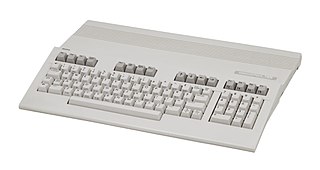
The Commodore 128, also known as the C128, C-128, or C= 128, is the last 8-bit home computer that was commercially released by Commodore Business Machines (CBM). Introduced in January 1985 at the CES in Las Vegas, it appeared three years after its predecessor, the Commodore 64, the bestselling computer of the 1980s. Approximately 2.5 million C128s were sold during its four year production run.

The Commodore PET is a line of personal computers produced starting in 1977 by Commodore International. A single all-in-one case combines a MOS Technology 6502 microprocessor, Commodore BASIC in read-only memory, keyboard, monochrome monitor, and, in early models, a cassette deck.
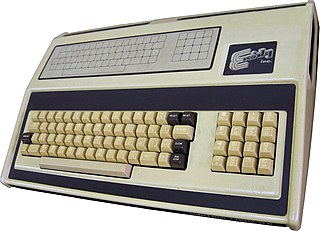
The Sorcerer is a home computer system released in 1978 by the video game company Exidy, later under their Exidy Systems subsidiary. Based on the Zilog Z80 and the general layout of the emerging S-100 standard, the Sorcerer was comparatively advanced when released, especially when compared to the contemporary more commercially successful Commodore PET and TRS-80. The basic design was proposed by Paul Terrell, formerly of the Byte Shop, a pioneering computer store.

The TI-99/4 and TI-99/4A are home computers released by Texas Instruments in 1979 and 1981, respectively. The TI-99 series competed against home computers such as the Apple II, TRS-80, Atari 400/800, and VIC-20.

The Commodore 16 is a home computer made by Commodore International with a 6502-compatible 7501 or 8501 CPU, released in 1984 and intended to be an entry-level computer to replace the VIC-20. A cost-reduced version, the Commodore 116, was mostly sold in Europe.

The Commodore Plus/4 is a home computer released by Commodore International in 1984. The "Plus/4" name refers to the four-application ROM-resident office suite ; it was billed as "the productivity computer with software built in".
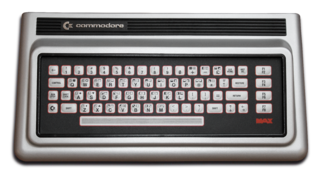
MAX Machine, also known as Ultimax in the United States and Canada and VC-10 in Germany, is a Video game console designed and sold by Commodore International in Japan, beginning in early 1982, a predecessor to the popular Commodore 64, also sharing a lot of components with the C64. The Commodore 64 manual mentions the machine by name, suggesting that Commodore intended to sell the machine internationally; however, it is unclear whether the machine was ever actually sold outside Japan. When it was officially presented, in Tokyo, for the first time, it was named Commodore VICKEY.
Commodore BASIC, also known as PET BASIC or CBM-BASIC, is the dialect of the BASIC programming language used in Commodore International's 8-bit home computer line, stretching from the PET (1977) to the Commodore 128 (1985).

The Mindset is an Intel 80186-based MS-DOS personal computer. It was developed by the Mindset Corporation and released in spring 1984. Unlike other IBM PC compatibles of the time, it has custom graphics hardware supporting a 320×200 resolution with 16 simultaneous colors and hardware-accelerated drawing capabilities, including a blitter, allowing it to update the screen 50 times as fast as an IBM standard color graphics adapter. The basic unit was priced at US$1,798. It is conceptually similar to the more successful Amiga released over a year later. Key engineers of both the Amiga and Mindset were ex-Atari, Inc. employees.

The Commodore 65 is a prototype computer created at Commodore Business Machines in 1990–1991. It is an improved version of the Commodore 64, and it was meant to be backwards-compatible with the older computer, while still providing a number of advanced features close to those of the Amiga.

The Commodore CBM-II series is a short-lived range of 8-bit personal computers from Commodore Business Machines (CBM), released in 1982 and intended as a follow-on to the Commodore PET series.
BASIC 8 – "The Enhanced Graphics System For The C128" – was an American-designed graphics system developed by Walrusoft of Gainesville, Florida and published in 1986 by Patech Software of Somerset, New Jersey. The system was an extension of Commodore's BASIC 7.0 for the C128 home/personal computer. BASIC 8.0 provided commands lacking in BASIC 7.0 to generate (color) graphics in the C128's high-resolution 80-column mode for RGB monitors.

The Commodore 64 home computer used various external peripherals. Due to the backwards compatibility of the Commodore 128, most peripherals would also work on that system. There is also some compatibility with the VIC-20 and Commodore PET.

A fast loader is a software program for a home computer, such as the Commodore 64 or ZX Spectrum, that accelerates the speed of file loading from floppy disk or compact cassette.

Michael S. Tomczyk is best known for his role in guiding the development and launch of the first microcomputer to sell one million units, as Product Manager of the VIC-20 from Commodore. His contributions are described in detail in his 1984 book, THE HOME COMPUTER WARS: An Insider's True Account of Commodore and Jack Tramiel. His role is also documented extensively in numerous interviews and articles. The VIC-20 was the first affordable, full-featured color computer and the first home computer to be sold in KMart and other mass market outlets. Michael joined Commodore in April 1980 as Assistant to the President. He has been called the "marketing father" of the home computer. Michael was also a pioneer in telecomputing, as co-designer of the Commodore VICModem, which he conceived and contracted while at Commodore. The VICModem was the first modem priced under $100 and the first modem to sell one million units.

Home computers were a class of microcomputers that entered the market in 1977 and became common during the 1980s. They were marketed to consumers as affordable and accessible computers that, for the first time, were intended for the use of a single, non-technical user. These computers were a distinct market segment that typically cost much less than business, scientific, or engineering-oriented computers of the time, such as those running CP/M or the IBM PC, and were generally less powerful in terms of memory and expandability. However, a home computer often had better graphics and sound than contemporary business computers. Their most common uses were word processing, playing video games, and programming.

